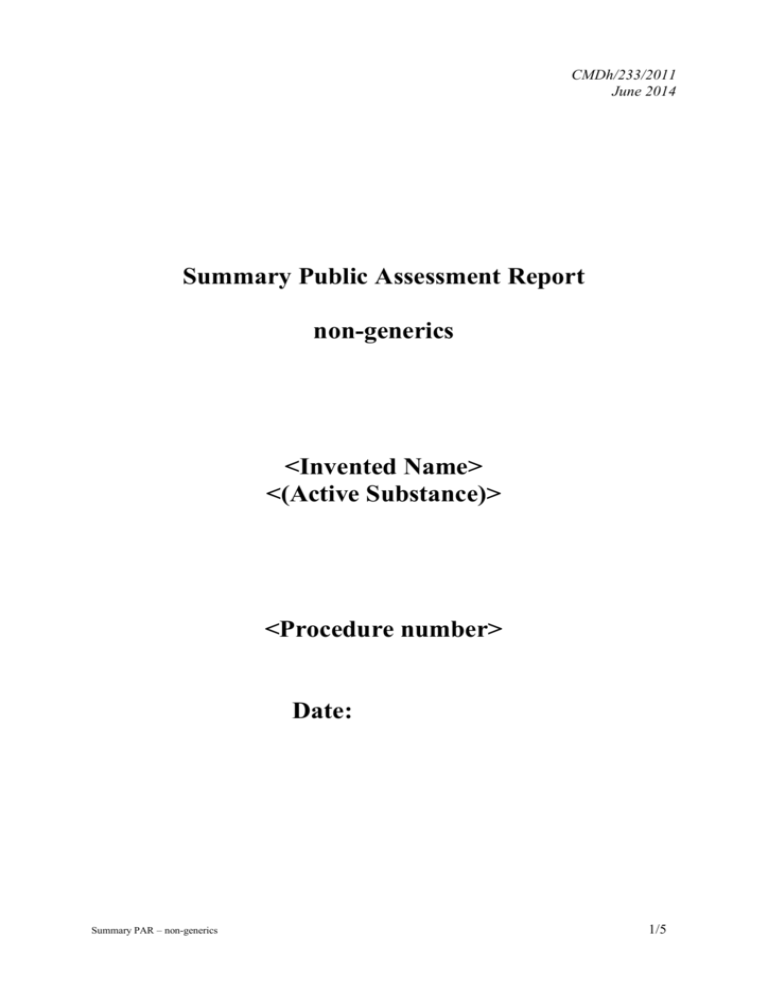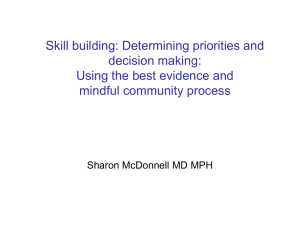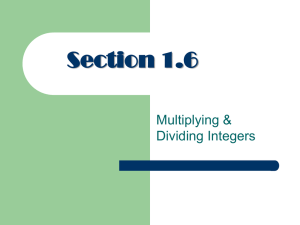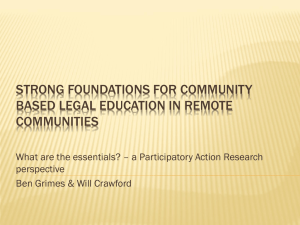Summary PAR for non-generics (June 2014)
advertisement

CMDh/233/2011 June 2014 Summary Public Assessment Report non-generics <Invented Name> <(Active Substance)> <Procedure number> Date: Summary PAR – non-generics 1/5 Summary Public Assessment Report non-generics General guidance: In principle information from the PL should be included and standard texts/sentences should be used where possible. <invented name of product> <active substance/common name, pharmaceutical form and strength> This is a summary of the public assessment report (PAR) for <X>. It explains how <X> was assessed and its authorisation recommended as well as its conditions of use. It is not intended to provide practical advice on how to use <X>. For practical information about using <X>, patients should read the package leaflet or contact their doctor or pharmacist. What is <X> and what is it used for? For full applications there is a standard statement to use: <X is used in the treatment of/X can be used by patients who…> <Include the relevant information on indications, e.g. copy the relevant information from PL section “What X is and what is it used for”. Note that the PL is directed to the patient, rewrite accordingly if necessary.> For informed consent applications (X based on Y) there is a standard statement to use: ‘This medicine is the same as <Y>, which is already authorised. The company that makes <y> has agreed that its scientific data can be used as a basis for the grant of identical licence for <X> (informed consent). <X is used in the treatment of/X can be used by patients who…> <Include the relevant information on indications, e.g. copy the relevant information from PL section “What X is and what is it used for”. Note that the PL is directed to the patient, rewrite accordingly if necessary.> For well-established use applications there is a standard statement to use: <X> is a medicine with ‘well-established use’. This means that the medicinal use of the active substance of <X> is well established in the European Union for at least ten years, with recognised efficacy and an acceptable level of safety. <X is used in the treatment of/X can be used by patients who…> <Include the relevant information on indications, e.g. copy the relevant information from PL section “What X is and what is it used for”. Note that the PL is directed to the patient, rewrite accordingly if necessary.> Summary PAR – non-generics 2/5 For hybrid applications (X based on Y) there is a standard statement to use: <X> is a ‘hybrid generic medicine’. This means that it is similar to a reference medicine containing the same active substance, but….. <explain differences from reference product, e.g. - is given in a different way> - is available as <pharmaceutical form> - is given by <route of administration> The company has provided additional own data to demonstrate the safety and efficacy of <X> regarding this difference from the reference medicine. The reference medicine for X is Y. <X is used in the treatment of/X can be used by patients who…> <Include the relevant information on indications, e.g. copy the relevant information from PL section “What X is and what is it used for”. Note that the PL is directed to the patient, rewrite accordingly if necessary.> For products with other legal basis Specify: <X is used in the treatment of/X can be used by patients who…> <Include the relevant information on indications, e.g. copy the relevant information from PL section 1 “What X is and what is it used for”. Note that the PL is directed to the patient, rewrite accordingly.> Further guidance for text to be included on where the product is used for: Use bullet points for multiple indications. How does <X> work? <Copy the relevant information from Section 1 of the PL “What X is and what is it used for”. Note that the PL is directed to the patient, rewrite accordingly if necessary. If relevant, add information from Section 5.1 in the SmPC, reworded in lay terms.> How is <X> used? The pharmaceutical form of <X> is <pharmaceutical form> and the route of administration is <route of administration>. Please read section 3 of the PL for detailed information on dosing recommendations, the route of administration, and the duration of treatment. <This section should include: pharmaceutical form(s); main dosing recommendations; route/method of administration; duration of treatment if specified; need for any specific monitoring of certain parameters or for diagnostic tests; prescription status.> <The medicine can only be obtained with a prescription.> <The medicine can be obtained without a prescription.> Summary PAR – non-generics 3/5 What benefits of <X> have been shown in studies? For full applications the following statements can be used: The company provided its own data on efficacy and safety studies. In these studies X was more effective than placebo (dummy treatment) at improving <mention symptoms that are treated> in patients with < include indication(s)>. OR These studies have shown that X is effective in treating <include indication>. For well-established use applications the following statement can be used: As <include active substance of X> is a well-known substance, and its use in the treatment of <include approved indication> is well established, the applicant presented data from the scientific literature. The literature provided confirmed the efficacy and safety of <include active substance of X> in the treatment of <include approved indication>. For informed consent applications (X based on Y) the following statement can be used: X is considered identical to previously authorised Y, with the same benefits and risks. So no new studies have been provided for X but reference is made to the studies for Y. For hybrid applications (X based on Y) the following statement can be used: For locally acting products Because X is a hybrid application and is considered to be therapeutically equivalent, to the reference product Y, their benefits and risks are taken as being the same as those of the reference medicine For products which differ in e.g. pharmaceutical form of Y and additional studies are required: Because X is a hybrid application of Y, clinical studies have been provided for X to show efficacy for the difference of X from the reference product Y. What are the possible side effects from X? The most common side effects with <X> (which may affect more than 1 in 10 people) are…> <The most common side effects with <X> (which may affect up to 1 in 10 people) are…> <For the full list of all side effects reported with <X>, see section 4 of the package leaflet.> <For the full list of restrictions, see the package leaflet.> <Mention contraindications, excluding hypersensitivity to the active substance. Also include a standard reference to the PL for the full list. In addition, mention the main safety concerns identified in part VI of the RMP.> Why is <X> approved? <This section summarises the benefit/risk discussion using lay language, drawing on the information in section 3 of the Assessment Report,> The < name agency> decided that <X>’s benefits are greater than its risks and recommended that it be approved for use. Summary PAR – non-generics 4/5 If applicable: <<X> has been authorised under ‘exceptional circumstances’. This means that it has not been possible to obtain complete information about <X> due to <insert reason based on rarity/scientific/ethical grounds (see also PAR)>. Every year, the national Agencies will review any new information that becomes available and this summary will be updated as necessary.> Or <<X> has been authorised with the condition to perform further studies and/or to provide additional measures to minimise the risk. See section below “What measures are being taken to ensure the safe and effective use of <X>?” What measures are being taken to ensure the safe and effective use of <X>? A risk management plan has been developed to ensure that <X> is used as safely as possible. Based on this plan, safety information has been included in the summary of product characteristics and the package leaflet for <X>, including the appropriate precautions to be followed by healthcare professionals and patients. Known side effects are continuously monitored. Furthermore new safety signals reported by patients/healthcare professionals will be monitored/reviewed continuously as well. <if applicable: describe additional risk management measures (also mentioned in the AR), such as obligations to provide educational materials, establish patient registries, or carry out further studies e.g. in specific populations or for long-term safety/efficacy data.> Other information about <X> The marketing authorisation for <X> was granted on < date of issue of the Marketing Authorisation>. The full PAR for <X> can be found on the website <add link to product index>. For more information about treatment with <X>, read the package leaflet (link)or contact your doctor or pharmacist. This summary was last updated in MM-YYYY. Summary PAR – non-generics 5/5







